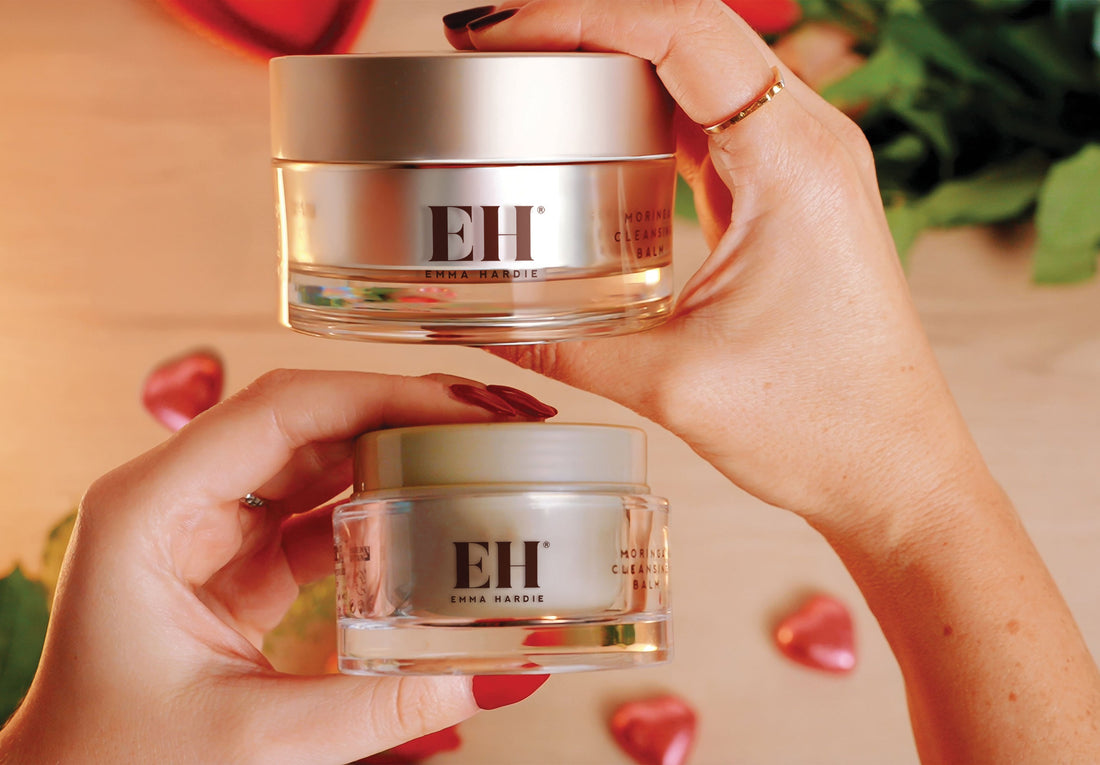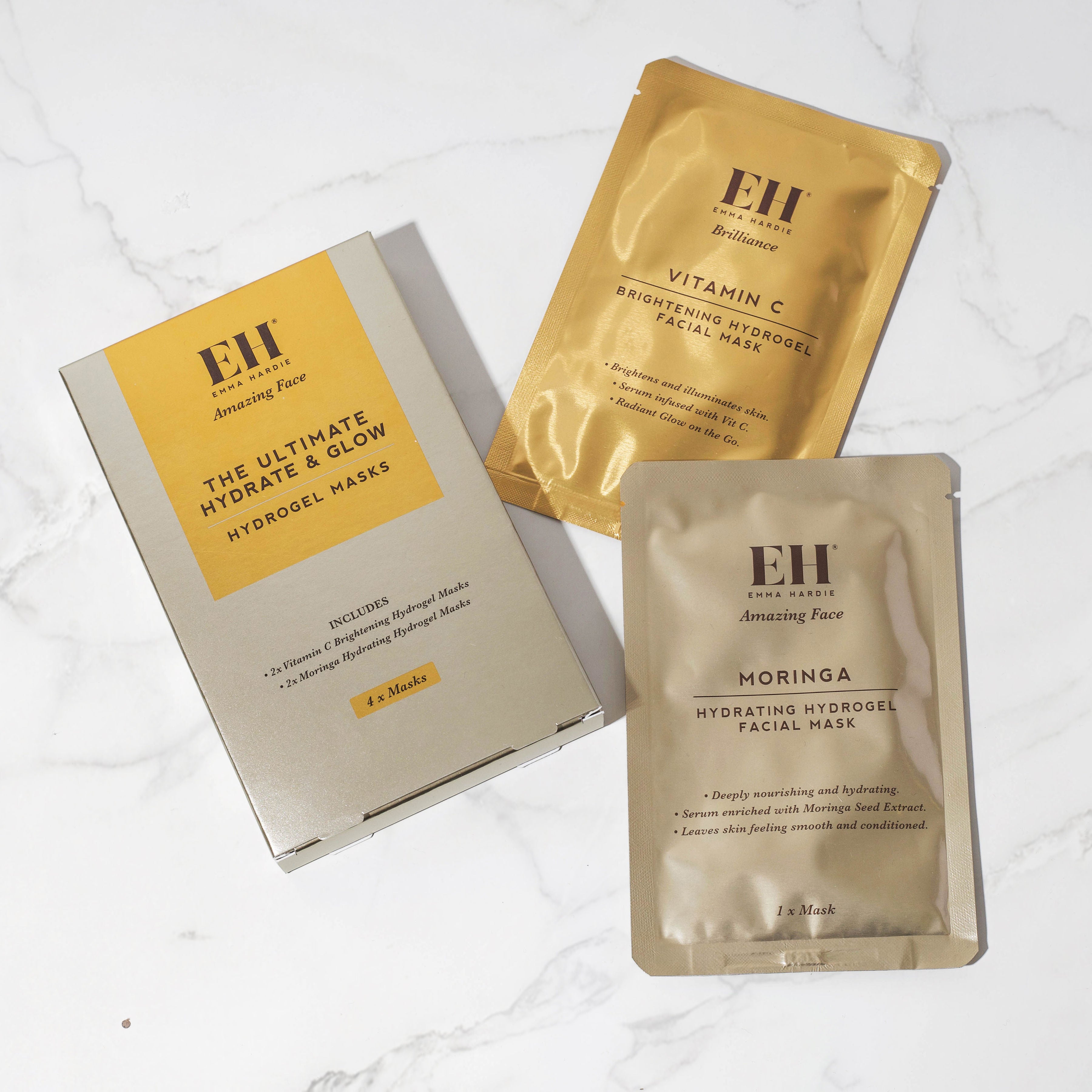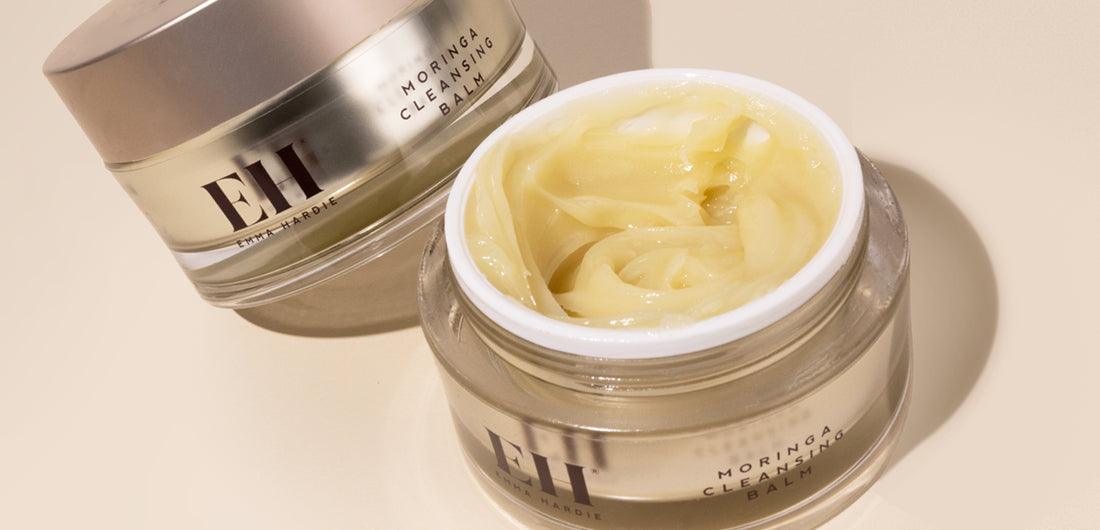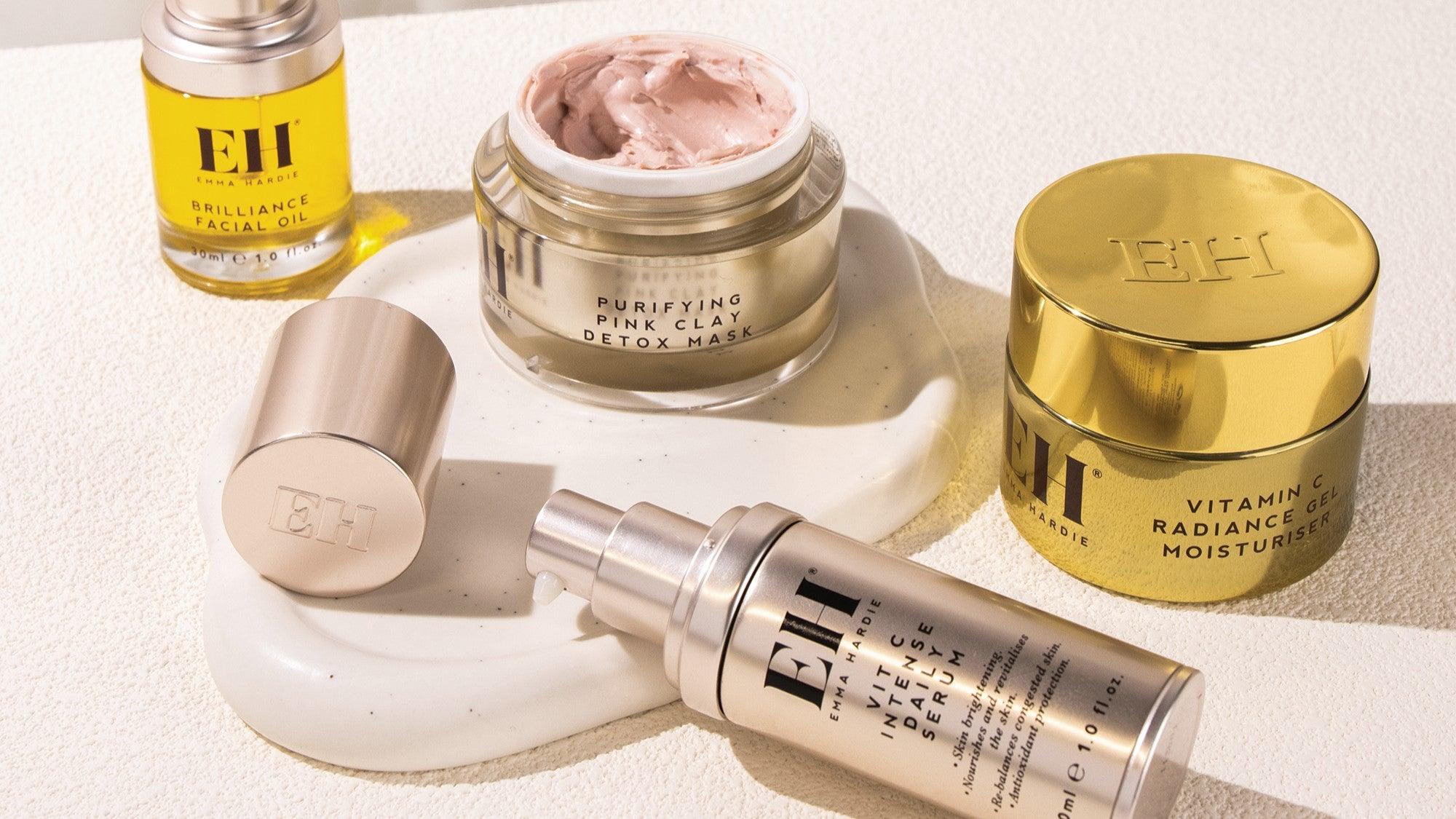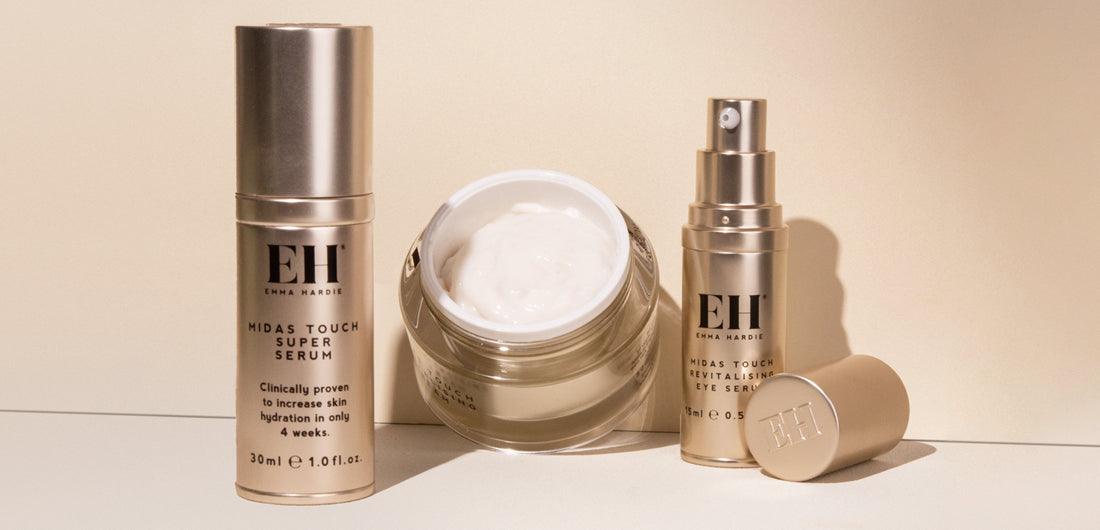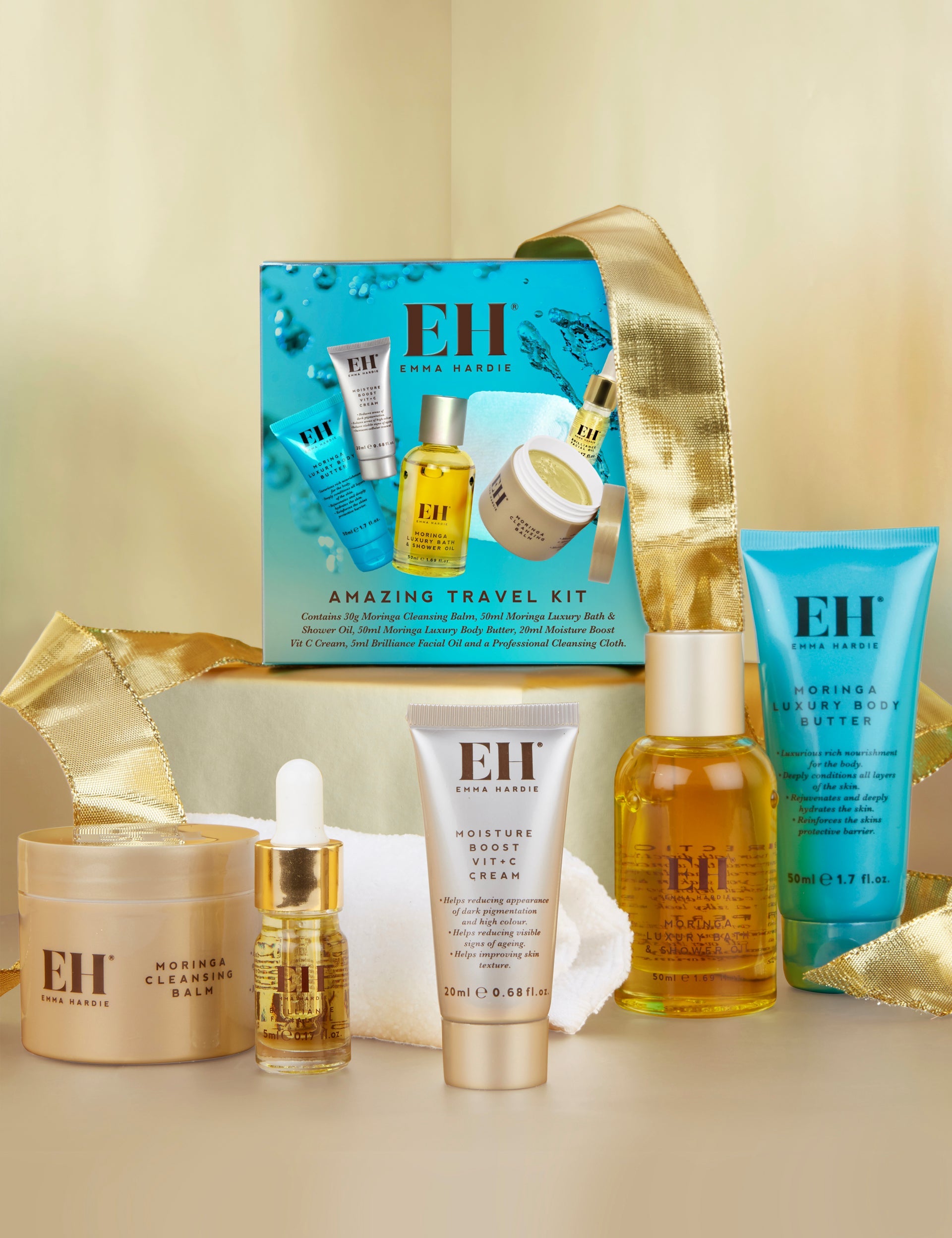
Skincare to go
Whether jetting off for a special trip or packing for a staycation, there’s no longer a reason to be without your skincare non-negotiables.
Emma Hardie travel kits contain mini versions of skincare favourites to ensure you never have to skip a step in your morning and evening routine.
Emma Hardie skincare is packed full of powerful natural botanical ingredients to help skin stay hydrated, protected and looking radiant every day.
Discover our travel collection…
Hydration on the go £12.50 / €15 (WORTH £28)
Two bestsellers in a handy travel size, the Moringa Cleansing Balm and Midas Touch Revitalising Cream will keep skin feeling fresh and hydrated all holiday.
Includes:
• Moringa Cleansing Balm 15ml
• Midas Touch Revitalising Cream 15ml
Amazing Face Spa Collection £39 / €46.50 (WORTH £102)
Everything you need to give yourself a luxury facial experience in one convenient kit.
Includes:
• Moringa Cleansing Balm 30ml
• Midas Touch Revitalising Cream 15ml
• Plump & Glow Hydrating Facial Mist 30ml
• Protect & Prime SPF30 20ml
• Brilliance Facial Oil 5ml
• Moringa Luxury Hand & Nail Treatment SPF30 50ml
Hydrate & Protect Kit £40 / €50 (WORTH £86)
A 50ml of the iconic Moringa Cleansing Balm plus three travel sized minis to keep skin hydrated and protected.
Includes:
• Moringa Cleansing Balm 50ml
• Protect & Prime SP30 15ML
• Purifying Pink Clay Detox Mask 15ml
• Midas Touch Revitalising Cream 15ml
• Professional Dual Action Cleansing Cloth
Related Posts
Understanding Different Skin Types Throughout the Seasons
The Best Skincare Routines for Oily, Dry, and Blemish-Prone Skin Throughout the Seasons Are you struggling to find the right skincare routine for your oily, dry, or blemish-prone skin? Many people face this challenge, especially as seasons change. This post will provide effective skincare routines tailored to each skin type throughout the year. You will learn about key ingredients that enhance skin health and common mistakes to avoid. By addressing these factors, you can reduce itchiness and improve your skin's appearance, ensuring a more comfortable relationship with cosmetics and overall skin health. Oily skin is characterized by excess sebum production, often leading to a shiny appearance and larger pores. Dry skin symptoms include tightness, flaking, and redness, sometimes linked to conditions like dermatitis. Blemish-prone and sensitive skin may exhibit inflammation and irritation, making it crucial to tailor skincare approaches based on seasonal changes and factors like hormone fluctuations and ageing. Characteristics of Oily Skin Oily skin is marked by an overproduction of sebum, which can lead to a shiny complexion and enlarged pores. Individuals with this skin type often experience a constant battle with excess fat, making it essential to choose products wisely. Incorporating lightweight powders and formulas that contain hyaluronic acid can help balance hydration without exacerbating oiliness. During different life stages, such as menopause, the skin may undergo changes that can intensify oiliness or alter its overall texture. Allergies can also play a role, causing inflammation and irritation. To manage these effects, individuals should adapt their skincare routines to include gentle cleansers and non-comedogenic moisturizers that address both oiliness and any underlying sensitivities. Identifying Dry Skin Symptoms Dry skin can manifest through several symptoms, including tightness, flaking, and redness. Individuals experiencing these issues may feel an increased risk of skin irritations, which could be exacerbated by factors such as food allergies or environmental conditions. Therefore, using a broad-spectrum sunscreen is essential, as it can help protect against further dryness and irritation caused by sun exposure. Moreover, individuals with chronic conditions, such as chronic kidney disease, may notice heightened skin sensitivity, making tailored skincare routines even more critical. Incorporating hydrating products that support weight management in skincare can also be beneficial, as maintaining a healthy lifestyle contributes to overall skin health. Adequate moisture and protection are key to alleviating discomfort and enhancing the skin's natural barrier. Recognizing Blemish-Prone and Sensitive Skin Blemish-prone and sensitive skin often requires special attention to avoid irritation and inflammation. Individuals dealing with these skin types may notice increased reactions to ingredients in their skincare products, making it important to select gentle cleansers free from harsh chemicals. Additionally, incorporating natural alternatives like bakuchiol can provide anti-inflammatory benefits while minimizing the risk of irritation, a concern that is especially relevant for many residing in the United Kingdom who are exposed to varying environmental factors. Seasonal Skincare Routines for Oily Skin For oily skin, establishing effective seasonal skincare routines is vital. The summer routine focuses on lightweight ingredients, utilizing vitamin-rich products that control oil without clogging pores. In winter, adapting to heavier moisturizers post-shower can combat dryness. Spring and fall routines should incorporate balancing elements, adjusting based on humidity levels, to maintain optimal skin condition. Morning and Evening Routine for Summer In the summer months, those with oily skin should prioritize a morning routine that focuses on balancing the epidermis without over-drying. A gentle, foaming cleanser can effectively remove excess oil while maintaining moisture, preventing the need for topical steroids that may be prescribed for more severe skin conditions. Following cleansing, applying a lightweight, oil-free moisturizer, such as the Lancome Nutrix Royal Body, can hydrate the skin without causing breakouts, making it vital for sensitive skin types during this season. The evening routine should involve a thorough cleansing to rid the skin of impurities accumulated throughout the day. An exfoliating product can help clear out clogged pores, while a calming serum with ingredients designed for sensitive skin can enhance recovery overnight. This approach not only aids in maintaining skin clarity but also strengthens the overall condition of the skin, reducing the likelihood of requiring intervention at a hospital for escalating issues. Adapting Your Skincare for Winter In winter, individuals with oily skin must adjust their skincare routines to combat the drying effects of colder weather. Implementing a hydrating gel moisturizer that includes ingredients like zinc can help maintain balance without overwhelming the skin. A focus on gentle cleansing is critical, as harsh products may strip away necessary moisture, leading to increased oil production and breakouts. Incorporating retinol into the evening routine can significantly benefit oily skin during winter months. This powerful ingredient aids in skin renewal and keeps pores clear, reducing the likelihood of blemishes. Meanwhile, using sunscreen remains essential, as UV exposure can still occur even in colder weather, helping to protect the skin from long-term damage and ensuring overall skin health. Spring and Fall Routine Adjustments During spring and fall, individuals with oily skin should make adjustments to their routines to address the changing weather. Incorporating lightweight serums enriched with vitamin A can promote cell turnover while maintaining hydration. This is especially beneficial for those who experience conditions such as rosacea or rashes, as balancing skin texture becomes crucial during these transitional months. Ensuring the use of non-comedogenic products helps prevent breakouts exacerbated by increased humidity or colder air. In these seasons, it's also essential to consider the impact of hair products on facial skin. Many styling products can block pores and contribute to the appearance of blemishes. Opting for clarifying cleansers once a week can provide deep cleansing, removing build-up from products that may irritate the skin's surface. Implementing a strategy that blends therapeutic formulations with nourishing treatments ensures the skin remains clear and resilient through changing environmental factors. Seasonal Skincare Routines for Dry Skin Summer routines for dry skin should focus on hydration, utilizing gentle cleansers and products with aloe vera to moisturize effectively. During colder months, essential winter care involves thicker creams and strategizing nutrition and medication to enhance skin health. In spring and fall, incorporating lightweight products helps maintain moisture balance, while careful clothing choices can further protect the skin from environmental stressors. Morning and Evening Routine for Summer During summer, individuals with dry skin should prioritize hydration in their morning routine. Starting with a gentle cleanser removes impurities without stripping moisture, following up with a hydrating toner can help restore the skin's balance. Incorporating a moisturizer such as Clinique Smart SPF 15 not only provides essential hydration but also adds a layer of sun protection, which is critical in warmer months, as recommended by the American Academy of Dermatology. In the evening, it is important to nourish and repair the skin after a long day. A rich, hydrating cream can be applied to ensure skin feels soft and smooth by morning. If dryness persists, a few drops of facial oil can offer additional moisture, helping to achieve that coveted glass-like finish while effectively combating any flakiness often experienced during summertime. Essential Winter Care for Dry Skin During winter, individuals with dry skin often face heightened sensitivity, requiring specialized care. Using a thick, nourishing lotion is essential to combat moisture loss and provide lasting hydration. Products formulated with ingredients like shea butter or ceramides can significantly improve the skin's barrier function, making it suitable for those with sensitive skin who may be prone to irritation from harsh winter conditions. Incorporating a gentle deodorant into daily routines can also help maintain comfort without further dryness. For nursing mothers, ensuring that the skin remains well-hydrated is vital; this can be achieved by applying a rich cream to both the skin and nails, protecting against brittleness and promoting overall skin health in the colder months. Such focused attention to skin care can lead to a noticeable reduction in discomfort and enhance the appearance of the skin throughout winter. Spring and Fall Tips for Hydration During spring and fall, maintaining hydration for dry skin is essential due to fluctuating weather conditions. Using a moisturizer that protects against ultraviolet rays while locking in moisture is beneficial, especially after exercising outdoors. Products containing natural oils can soothe the skin and counteract the drying effects caused by environmental factors and gentle detergents found in clothing. In addition, individuals should adjust their skincare routine to include specific practices such as hydrating after shaving to prevent irritation. Incorporating a hydrating serum or essence before applying moisturizer can significantly improve skin texture. Staying aware of how external factors affect skin health allows for proactive changes that result in a more resilient and balanced complexion throughout the seasons, addressing the common worries associated with dry skin. Seasonal Skincare Routines for Blemish-Prone and Sensitive Skin Managing breakouts during summer requires lightweight products that help control oil while preventing clogging pores. In winter, utilizing soothing creams like Vichy Thermal Rich Cream creates a protective barrier essential for sensitive skin. Spring and fall care should focus on adjusting routines to include gentle acids that support skin health, considering factors like genetics and conditions such as xeroderma. Managing Breakouts During Summer Managing breakouts during the summer months requires a skincare approach tailored to the heat and its effects on the skin. Products infused with ingredients that support cell renewal and balance oil production can be effective. For instance, using a lightweight moisturizer like Teoxane Advanced Filler can provide hydration without clogging pores, helping to minimize the occurrence of blemishes. In addition to selecting the right skincare products, maintaining proper cleansing routines is essential. A gentle cleanser designed for blemish-prone skin can remove excess oil and impurities without causing irritation. By incorporating these practices into a summer beauty regimen, individuals can enhance their skincare effectiveness and achieve clearer, healthier skin while navigating the challenges posed by warmer temperatures. Winter Strategies for Sensitive Skin During the winter months, individuals with sensitive skin need to focus on incorporating rich, nourishing creams that provide substantial hydration. Products formulated with antioxidants can be particularly beneficial, as they help combat oxidative stress and support skin healing. Since lower humidity levels in winter can exacerbate acne and irritation, utilizing creams that establish a protective barrier is essential for maintaining skin comfort and clarity. Additionally, as the skin is likely to experience increased dryness after hair removal procedures, using soothing creams can minimize irritation and promote smoother skin. Selecting products designed to hydrate and calm sensitive skin not only helps to alleviate discomfort but also addresses potential acne flare-ups that can be triggered by environmental changes. By prioritizing these strategies, individuals can ensure their skin remains balanced and healthy throughout the colder season. Spring and Fall Care for Blemish-Prone Skin In the spring and fall, individuals with blemish-prone skin should focus on maintaining moisture balance while combating the effects of fluctuating weather. Incorporating a lightweight moisturizer enriched with hydrating ingredients can help prevent dryness without clogging pores. Utilizing a humidifier indoors can also improve skin texture by adding needed moisture to the air, reducing the risk of irritation that can lead to blemishes and potential scars. To support overall skin health, incorporating clay masks into the routine can effectively draw out impurities and excess sebum, minimizing the appearance of wrinkles and promoting a smoother complexion. Regular use of gentle exfoliating products can enhance cell turnover, fostering a clearer appearance. By strategically adapting skincare practices during these transitional months, individuals can improve their blemish-prone skin's resilience and radiance. Key Ingredients to Look for in Each Season Finding the right ingredients for various skin types is crucial for effective seasonal skincare routines. For oily skin, ingredients that help balance sebum production are essential, while nourishing components are vital for dry skin to maintain hydration and comfort. Additionally, soothing elements help minimize irritation for sensitive skin, ensuring a comprehensive approach to skincare that addresses individual needs. Products like Vichy Aqualia Rich Cream can provide excellent hydration for those struggling with dryness, while avoiding strong perfumes can prevent flare-ups in sensitive skin. Best Ingredients for Oily Skin For those with oily skin, selecting the right ingredients can greatly enhance their skincare routine. Formulas that include salicylic acid are particularly beneficial, as they penetrate pores to reduce excess oil and prevent breakouts. Additionally, lightweight moisturizers enriched with hyaluronic acid provide hydration without adding excess weight, helping to manage the risks of hyperpigmentation often associated with oily skin types. Using petroleum-free products can further support skin health by minimizing clogging of pores. Blotting paper is also a practical tool for individuals to manage shine throughout the day; it helps absorb excess oil without disrupting makeup. By focusing on these ingredients and solutions, those with oily skin can achieve a clearer, healthier complexion while effectively addressing their specific concerns. Nourishing Ingredients for Dry Skin Nourishing ingredients play a vital role in addressing the challenges associated with dry skin. Products that contain hyaluronic acid provide powerful hydration, drawing moisture into the skin and helping maintain a healthy barrier. Additionally, formulations featuring glycerin can enhance hydration levels, which is particularly essential for those experiencing dryness due to factors such as hand washing or hormonal changes during pregnancy. For an added layer of comfort, using creams like Effeclar K can soothe irritated areas and prevent further disruption to sensitive skin conditions. In the quest for healthy skin, individuals should also prioritize ingredients that support the skin's natural oil glands. Emollients such as shea butter and lanolin effectively lock in moisture, preventing evaporation and keeping the skin feeling soft and smooth. These components are particularly beneficial during seasonal transitions when skin often gets dehydrated. Adopting a skincare routine that includes these nourishing ingredients helps combat dryness and enhances overall skin health, making a significant difference in the texture and appearance of dry skin. Soothing Components for Sensitive Skin For individuals with sensitive skin, incorporating soothing components into a skincare routine is essential for reducing irritation and maintaining comfort. Ingredients like chamomile and aloe vera provide calming effects, helping to alleviate redness and inflammation. Moreover, formulations containing salicylic acid can aid in gentle exfoliation, which minimizes breakouts while ensuring that skin remains stable and balanced without harsh reactions. In addition, medical-grade moisturizers often feature nourishing compounds such as ceramides and glycerin, which effectively strengthen the skin's barrier. Utilizing these elements ensures hydration is locked in while protecting against environmental aggressors. Individuals should consider integrating retinoids at a lower concentration to promote cell turnover, addressing concerns about sensitivity while enhancing the overall appearance of their skin without causing undue stress. Common Skincare Mistakes to Avoid for Each Skin Type Over-exfoliating oily skin can strip natural oils, worsening its condition. For those with dry skin, skipping moisturizer leads to excessive dryness; using products with ceramides can help restore moisture. Individuals with blemish-prone skin often choose the wrong products, like petroleum jelly, which may clog pores. Each of these mistakes highlights the importance of tailored skincare routines that consider individual medical history and skin needs. Over-Exfoliating Oily Skin Over-exfoliating oily skin poses a significant risk, as excessive removal of natural oils leads to an imbalance. Research indicates that when oily skin is stripped too frequently, it can react by producing even more oil, creating a frustrating cycle. Individuals often rely on harsh soaps that promise to eliminate grease, but this approach can lead to increased irritation and sensitivity. To prevent this issue, incorporating milder exfoliants that include beneficial ingredients like vitamin B3 can help maintain balance without sacrificing hydration. By avoiding aggressive scrubs and focusing on gentle exfoliation methods, individuals can manage excess oil without exacerbating their skin's condition. Understanding the impact of skin health on overall well-being is vital, as neglecting proper care can lead to more severe skin diseases over time. Skipping Moisturizer for Dry Skin Many individuals with dry skin mistakenly skip moisturizer, believing it does not suit their skin's needs. This oversight can lead to increased dryness and irritation, exacerbated by environmental factors like excessive hand sanitizer use or harsh weather. Incorporating products like Avene Trixera, which provide deep hydration, is essential for maintaining a healthy moisture barrier, ensuring the skin remains supple and protected, especially for those dealing with conditions like kidney disease that may contribute to skin sensitivity. Furthermore, using a lightweight serum can enhance hydration without overwhelming dry skin. Many people overlook the importance of moisture retention, thinking that their skin will improve with other treatments, such as those containing benzoyl peroxide. However, proper hydration through consistent use of quality moisturizers can alleviate discomfort and support overall skin health, making it crucial to integrate this step into daily routines. Wrong Products for Blemish-Prone Skin Choosing the wrong products for blemish-prone skin can exacerbate issues like seborrhoeic dermatitis, making it vital for patients to be selective about ingredients. Many individuals mistakenly use heavy creams or comedogenic products that can lead to clogged pores, causing more blemishes and irritation. For instance, during winter months, the use of occlusive formulas may feel soothing due to the effects of central heating, but these can worsen breakouts instead of providing relief. Stress also plays a significant role in skin health, and the choice of skincare can either alleviate or intensify this issue. Using products with harsh chemicals can lead to increased scaling and breakouts. A patient should look for gentle, non-comedogenic formulations that focus on calming and hydrating the skin, effectively managing blemishes while minimizing irritation. By understanding the right ingredients, individuals can better navigate their skincare routines and promote clearer, healthier skin. Conclusion Seasonal skincare routines tailored to oily, dry, and blemish-prone skin are essential for maintaining optimal skin health throughout the year. By adjusting routines to account for changing weather conditions, individuals can effectively manage sebum production, hydration levels, and sensitivity. Incorporating key ingredients suited to each skin type not only alleviates discomfort but also enhances overall skin appearance and resilience. Prioritizing personalized skincare practices empowers individuals to address their specific concerns and achieve healthier, more balanced skin all year long.
Learn moreWhy Moringa Cleansing Balm Is an Essential Addition to Your Skincare Routine
Why Moringa Cleansing Balm Is an Essential Addition to Your Skincare Routine Are you struggling to find an effective product that cleanses your skin without causing dryness? Moringa cleansing balm might be the solution you need. This article will explore the benefits of incorporating moringa cleansing balm into your skincare routine, the key ingredients that make it effective, and customer reviews that highlight its positive impact. Readers will discover how this plant-based product accounts for nourishment and hydration while cleaning the skin, helping to address common skincare challenges. Say goodbye to dull skin, and welcome a brighter, healthier complexion with insights from this comprehensive guide. Key Takeaways Moringa cleansing balm effectively removes impurities while nourishing the skin Rich in antioxidants, moringa helps protect against environmental damage The balm hydrates skin without causing irritation, suitable for all skin types Sustainable sourcing of moringa supports both the environment and ethical practices Users report significant improvements in hydration and overall skin texture after use Understanding the Benefits of Moringa Cleansing Balm Moringa boasts a rich nutritional profile, offering a variety of skin benefits, making its cleansing balm a standout choice. It nourishes while effectively removing impurities, often surpassing traditional products. This section will cover Moringa's unique ingredients, highlighting its natural perfume-like scent, the creamy texture reminiscent of milk, and the effectiveness of hazelnut oil. Readers will also learn about current promotions and sale prices to make informed purchases. Moringa's Nutritional Profile and Skin Benefits Moringa's rich nutritional profile makes it an excellent ingredient in cleansing balms, particularly due to its dual action of cleansing and nourishing the skin. Rich in antioxidants, moringa helps protect against environmental damage while soothing inflammation. The inclusion of beeswax enhances the balm's creamy texture, allowing it to glide smoothly on the skin and effectively lift away impurities, especially when paired with a muslin cloth for gentle exfoliation. How Moringa Cleansing Balm Compares to Other Products Moringa cleansing balm stands out among other cleansing products due to its unique properties that cater to various skin needs, including removing stubborn makeup like mascara while enhancing the complexion. Unlike traditional shampoos or foams that may strip the skin of essential moisture, this balm combines effective cleansing with nourishing agents, ensuring the skin remains hydrated. Reviews highlight its ability to provide a deep cleanse without irritation, making it an ideal choice for those seeking an effective yet gentle skincare solution. The Role of Moringa Cleansing Balm in Your Skincare Routine Moringa cleansing balm seamlessly integrates into daily skincare regimens, providing effective makeup removal while nourishing the skin. Understanding best practices enhances its benefits, such as pairing it with oils or incorporating rose extracts. This section will provide practical insights for optimal use to ensure skin remains healthy, free from alcohol-based irritants, and effectively cleansed of cosmetics. How to Integrate Moringa Cleansing Balm Into Daily Regimens Integrating moringa cleansing balm into daily skincare routines can significantly elevate their effectiveness. Users should apply the balm to dry skin, allowing the nourishing ingredients, such as citral and vitamin C, to cleanse and refresh, even around sensitive areas like the eyes. Employing a microfiber cloth during removal enhances the experience, while ascorbyl palmitate in the balm supports a healthy glow and protects the skin from environmental damage, making it a perfect addition for anyone seeking optimal skin health. Best Practices for Maximizing Its Benefits To maximize the benefits of moringa cleansing balm, users can enhance their routine by incorporating essential oils like jasminum officinale for added soothing properties. This combination, along with vitamin E, supports skin hydration and protection against damage while promoting a radiant complexion. For optimal results, especially in the United Kingdom’s varying climate, pairing the balm with citrus extracts can further invigorate and refresh the skin, ensuring a gentle yet effective cleanse. Key Ingredients in Moringa Cleansing Balm Active ingredients in moringa cleansing balm, such as triglycerides and citronellol, play significant roles in maintaining skin health. The balm’s formulation features natural components like crithmum, which enhance hydration and protect against environmental stressors. Understanding these elements will provide insights into how they contribute to an effective skincare routine, ensuring skin remains nourished, clean, and radiant. Active Ingredients and Their Functions The active ingredients in moringa cleansing balm contribute significantly to its effectiveness in maintaining skin health. For instance, prunus extract helps to hydrate the skin while enhancing its overall texture, making it ideal for those with dry or sensitive skin. Moreover, the presence of orange oil not only imparts a refreshing scent but also aids in deep cleansing, ensuring that users can purchase a product that truly meets their skincare needs while enjoying high ratings from the community. Importance of Natural Components for Skin Health Natural components, such as tocopherol and lecithin, play vital roles in promoting skin health, making them essential ingredients in moringa cleansing balm. Tocopherol, a form of vitamin E, acts as a powerful antioxidant, protecting the skin from damage caused by free radicals. Meanwhile, lecithin helps maintain the skin's moisture barrier, ensuring hydration remains intact even in challenging environments. Incorporating botanical elements like bitter orange peel not only adds a pleasant fragrance but also enhances the cleansing properties of the balm, ensuring users enjoy a refreshing and effective skincare experience while benefiting from the nourishing qualities of water and plant extracts. Customer Testimonials and Experiences With Moringa Cleansing Balm Users frequently report impressive outcomes after incorporating moringa cleansing balm into their skincare routines, noting significant improvements in skin texture and hydration. Illustrative before and after cases reveal its effectiveness in enhancing the skin's appearance, often complementing the use of acid-based products and toners. Testimonials also highlight the soothing properties from ingredients like neroli and the gentle formulation that features components such as benzyl alcohol, ensuring a refreshing and effective cleanse. Common Results and Observations Many users of moringa cleansing balm share positive observations regarding its impact on their beauty routines. They frequently note enhanced hydration and smoother skin texture, often attributing these results to key ingredients like linalool and fennel. The incorporation of grape and cotton extracts in the formulation further supports skin quality, making it a valued addition for those seeking a refreshing and effective cleanse. Users report improvements in skin hydration and texture. Ingredients like linalool and fennel contribute to soothing effects. Grape and cotton extracts enhance the overall cleansing experience. Illustrative Before and After Cases Illustrative before and after cases reveal the transformative effects of moringa cleansing balm on users' skin. Many individuals report noticeable increases in moisture levels after consistent use, effectively countering the drying effects typically associated with sunscreen and environmental radicals. For instance, one user shared that incorporating this balm into their daily facial routine significantly improved skin texture, leaving it feeling soft and rejuvenated. User Before Use After Use Key Improvements User 1 Dull skin, signs of dryness Radiant, hydrated skin Enhanced moisture retention, improved texture User 2 Rough patches, irritation Smooth, soothed complexion Reduced irritation, soothing effects User 3 Uneven tone, dryness Even skin tone, better hydration Improved tone, increased moisture Environmental and Ethical Considerations of Moringa Cleansing Balm Moringa cleansing balm is sourced sustainably, ensuring high-quality ingredients that promote environmental responsibility. This cleanser not only incorporates natural components like jasmine and geraniol but is also produced using cruelty-free and eco-friendly practices. The following sections will discuss the sustainability of moringa sourcing and the importance of ethical practices in skincare, spotlighting the benefits these elements bring to users and the planet. Sustainability of Moringa Sourcing The sustainability of moringa sourcing plays a crucial role in its appeal as a skincare product. Moringa trees are known for their resilience in polluted environments, making them a favorable choice for communities aiming to combat pollution while promoting eco-friendly practices. Additionally, essential oils such as mandarin orange and compounds like limonene enhance the product's aroma, adding to its overall effectiveness without compromising environmental values. Companies committed to ethical sourcing often incorporate ingredients from plants such as juniperus virginiana and vitis, ensuring that their cleansing balms not only benefit users' skin but also support sustainable agriculture and environmental health. Cruelty-Free and Eco-Friendly Practices Moringa cleansing balm is celebrated not only for its skincare benefits but also for its commitment to cruelty-free and eco-friendly practices. Brands that produce this balm often emphasize sustainability, ensuring that no animal testing occurs during development, which appeals to ethically minded consumers. Utilizing natural ingredients such as citric acid and almond oil enhances its effectiveness while being mindful of the environment, allowing users to add to cart guilt-free products that are both kind to their skin and the planet. Commitment to cruelty-free practices ensures no animal testing is involved. Natural ingredients like citric acid and almond oil provide effective cleansing. Sustainability in sourcing supports eco-friendly practices. Products designed with ethical considerations meet the needs of conscious consumers. Frequently Asked Questions About Moringa Cleansing Balm This section addresses common usage concerns surrounding moringa cleansing balm while clarifying misconceptions and myths about moringa products. Readers will gain insights into the role of grape seed oil and its connection to vitis vinifera in enhancing skin care. Additionally, explanations of ingredients like phenoxyethanol will help demystify the formulation, ensuring informed choices when adding this balm to their cart. Addressing Common Usage Concerns Common concerns about using moringa cleansing balm often relate to its ingredients and effectiveness, especially for those new to this product. Users may wonder if moringa seed oil is suitable for all skin types or if it could cause irritation. It’s essential to note that moringa oil is rich in fatty acids and has anti-inflammatory properties, making it gentle on the skin while providing deep nourishment and hydration. This makes the balm an ideal choice for various skin types, including sensitive skin, ensuring a clean and healthy complexion. Concern Description Solution Ingredient Suitability Is moringa seed oil suitable for sensitive skin? Yes, due to its gentle, nourishing properties. Irritation Could moringa cleansing balm cause irritation? Generally unlikely; it's formulated to soothe and hydrate. Effectiveness Does it clean effectively without stripping moisture? Yes, it effectively cleanses while retaining skin hydration. Clarifying Misconceptions and Myths About Moringa Products Many misconceptions exist regarding moringa products, particularly around their suitability for various skin types. Some believe that the oil may cause breakouts due to its rich composition, but moringa cleansing balm is renowned for its gentle, hydrating properties, making it a reliable option even for sensitive skin. By clarifying these myths, consumers can feel more confident in their choice, knowing that this natural ingredient not only cleanses but also nourishes, enhancing overall skincare routines. Conclusion Moringa cleansing balm serves as a crucial component of an effective skincare routine, delivering both cleansing and nourishing benefits. Its rich blend of natural ingredients promotes hydration and protection, making it suitable for various skin types, including sensitive skin. Users experience noticeable improvements in skin texture and moisture levels, reinforcing its role in enhancing overall skincare results. By incorporating this balm, individuals can achieve a radiant complexion while supporting eco-friendly and ethical practices in their beauty regimen.
Learn moreFall in love with Moringa Cleansing Balm
Moringa Cleansing Balm The multi-award-winning and bestselling Moringa Cleansing Balm is a nourishing balm packed full of powerful botanical ingredients designed to deeply cleanse, remove all traces of makeup, and leave skin balanced, hydrated, and conditioned. Adored by makeup artists, celebrities, and influencers worldwide, the balm has become a cult favourite in the skincare community. Benefits of the Beauty Icon Removes all traces of makeup Deeply cleanses Minimises the appearance of pores Balances and brightens Hydrates, moisturises, and conditions Restores suppleness and elasticity Create Your Own Moringa Moment… Turn your cleansing routine into a daily self-care ritual and use the opportunity to take some time for yourself. The signature soft citrus scent of Moringa Cleansing Balm helps to relax and unwind and is perfect for creating your very own at-home spa. Click here to discover our cleansing selection.
Learn more



